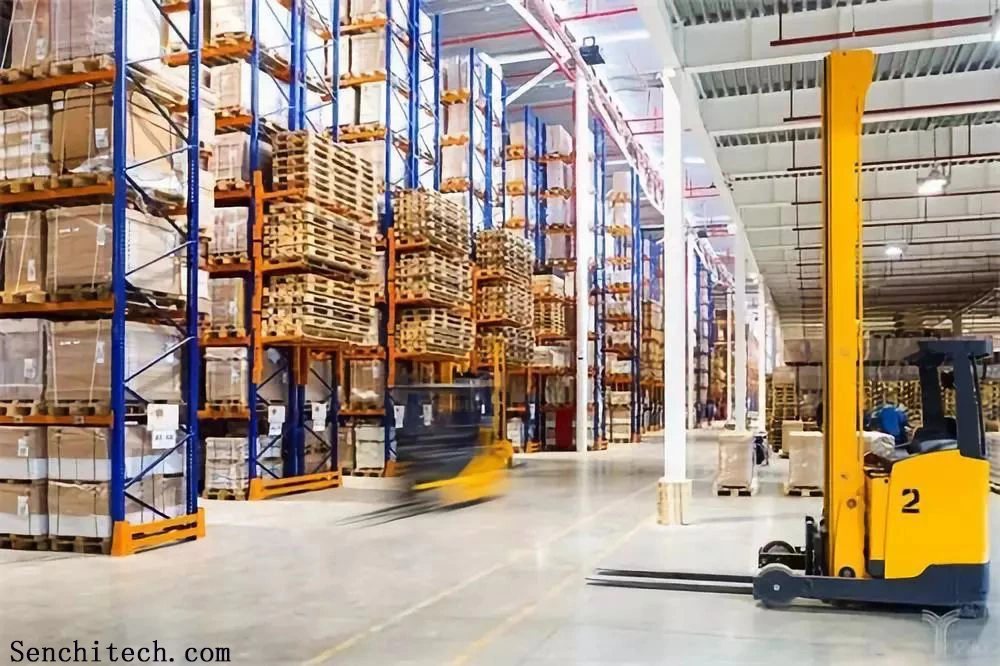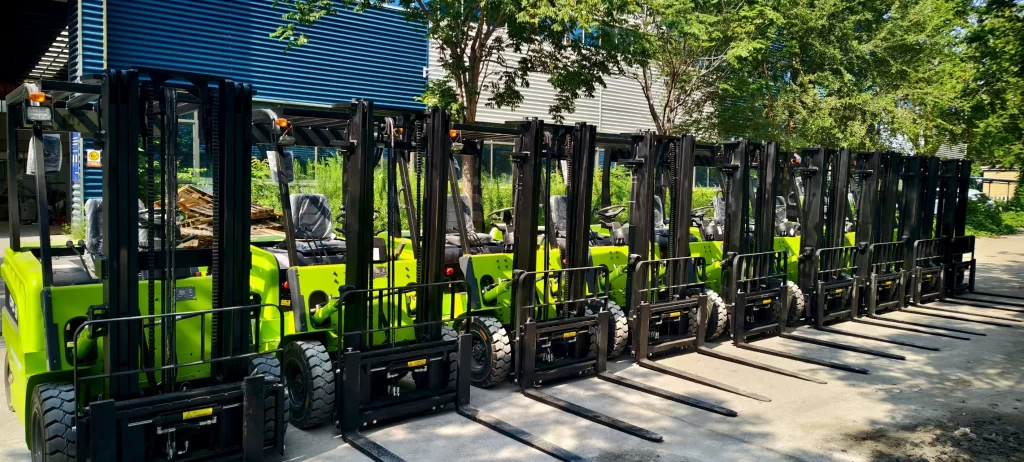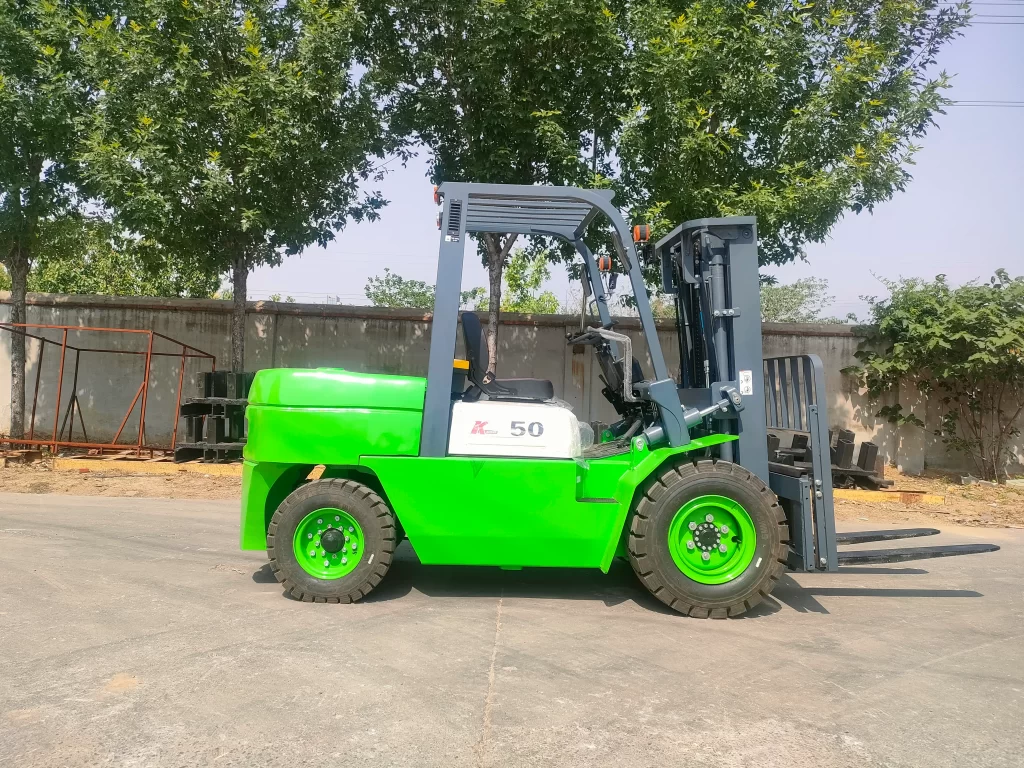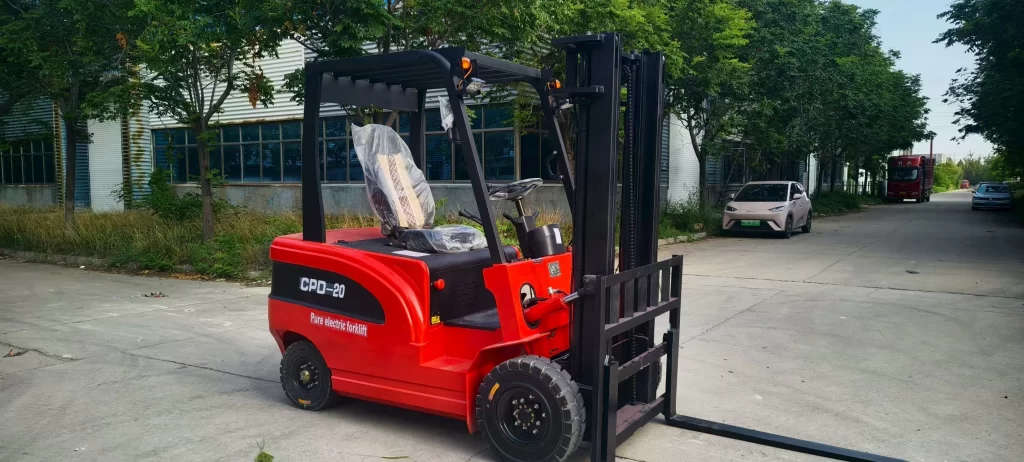Which is better, reach truck or VNA truck?
Reach trucks are indoor forklifts that operate by moving the forks or masts forward.
VNAs are battery-powered material handling machines designed for operation in narrow warehouse aisles. They combine vertical mast extension with an upright operator cabin to maximize storage density and efficiency. These forklifts are ideal for high-throughput logistics centers, offering zero emissions, lower operating costs, and increased flexibility in confined spaces.
Both have similar lifting heights and are used in high-density warehouses or busy logistics centers to maximize space utilization. However, both have their own unique advantages and are quite different machines.
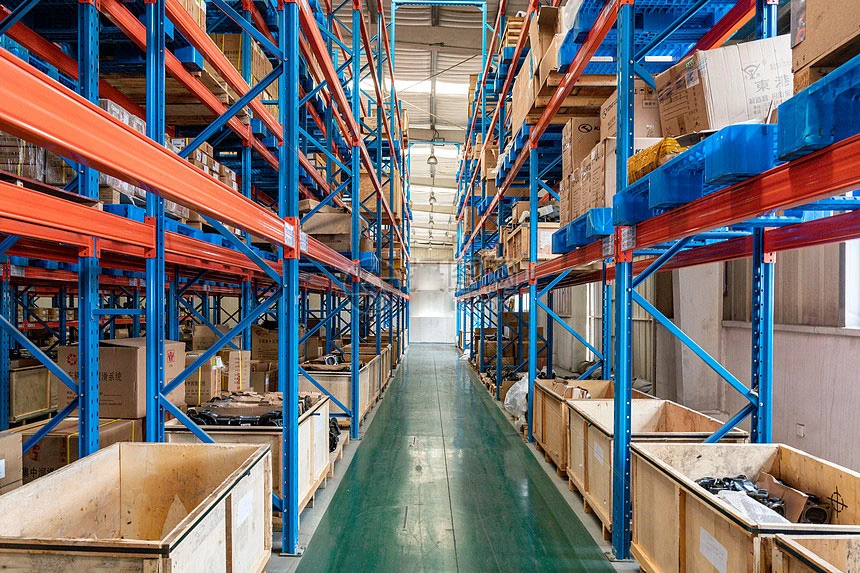
1. What is a reach truck? What is a VNA?
First, let’s briefly understand the differences between reach trucks and VNA forklifts.
1.1 Reach Truck Forklift
Definition: A forklift that operates by moving the forks or masts forward. o Operation Mode: Warehouse vehicles can be categorized as stand-up, sit-down, or walk-behind.
Aisle Requirements: Typically require an aisle width of 2.6 to 3.2 meters, narrower than typical counterbalanced electric forklifts.
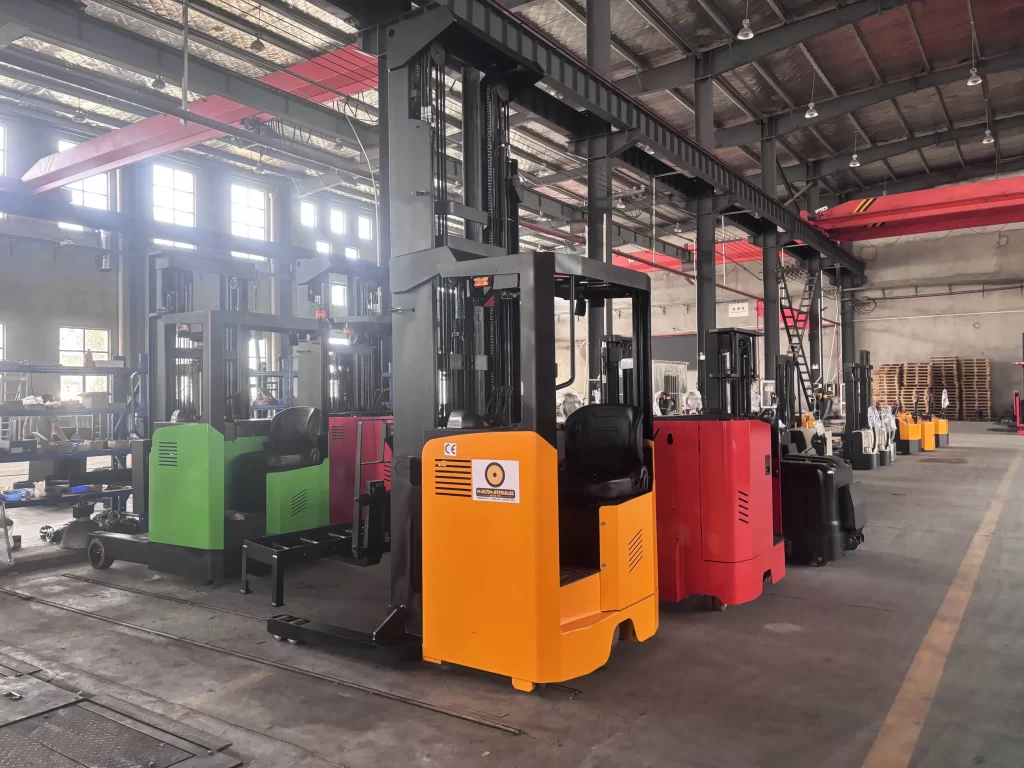
1.2 VNA (Very Narrow Aisle Truck)
efinition: A very narrow aisle (VNA) forklift turret truck is an electric forklift designed to operate in aisles that are typically narrower than standard forklift aisles (usually less than 6 feet wide). It features a turret-style rotating fork assembly that allows the operator to pick up and place loads on both sides of the aisle without rotating the entire forklift, making efficient use of limited space. It may or may not require a guide rail or guide system.
Operation Mode: Can be categorized as stand-up (operator ascends and descends with the vehicle) or picking (operator ascends and descends from the platform as the forks are lifted and lowered). Aisle Width Requirements: Aisles only need to be 1.6-2.0 meters wide (slightly wider than a pallet), which is generally sufficient to accommodate a VNA vehicle.
2. Similarities between reach trucks and VNA forklifts
What is the similar things of a reach truck vs VNA forklift? The following are main similarities of them.
2.1 Forklift Operating Environment.
Both are primarily indoor industrial vehicles used in large warehouses, aiming to maximize material stacking within limited space.
2.2 Power Source
Both are indoor industrial vehicles powered by batteries or electricity as their hydraulic systems. Batteries for these indoor forklifts can be categorized as lead-acid, lithium iron phosphate, and combination batteries. As an electric forklift manufacturer, we offer reach trucks equipped with maintenance-free lead-acid batteries, high-capacity lithium iron phosphate batteries, and combination batteries. We also offer lithium battery fast charging to shorten vehicle charging times.
2.3 Capacity
Both reach truck lifts and VNA vehicles have relatively low rated capacity, ranging from approximately 1 to 3 tons. Given current technological advancements, it’s natural for both to sacrifice load capacity in order to maximize vertical space. Furthermore, taller racks are not suitable for carrying heavier items, which increases costs and poses safety risks. Therefore, both currently strive to achieve optimal load and space utilization, while also considering safety concerns, by not carrying very heavy items.
2.4 Identical Models
There are some overlaps between reach trucks and VNAs. Actually, VNAs can also operate without a ground-based guidance system, literally speaking. The following models meet the VNA definition and are also reach trucks.
Three-Way Forklift: This model features a turret-type rotating fork assembly, allowing the operator to pick up and place items on both sides of the aisle without rotating the entire forklift, effectively utilizing limited space. The forklift’s 180-degree rotation and left and right lateral movement enable stacking of goods on both sides of ultra-narrow aisles (1.6 meters). The vehicle can pick up goods without turning within the aisle, effectively reducing the distance between racks. Rated load: 1000-1500kg, Lifting height: 6000mm
Articulated forklift: The 210° rotation of the mast structure coordinates the movement of the forks, enabling stacking of cargo on both sides of ultra-narrow aisles (2 meters). The large-diameter rubber wheels of this articulated forklift are suitable for both indoor and outdoor use.
Multi-directional reach truck: A multi-directional forklift is an extension of the forklift. In addition to longitudinal travel, it can also achieve lateral (sideways) travel by rotating the wheels 90 degrees. When traveling forward, its operating principle is basically the same as that of a counterbalanced forklift and a reach forklift. When traveling sideways, the forks are similar to those of a sidelift truck. Combining the advantages of a counterbalanced forklift, a reach forklift, and a sidelift truck, this new forklift type has emerged in the past decade or so. Its development stems from the evolution of traditional forklifts and sidelift trucks. Rated load capacity is approximately 1500-2500 kg, and the lifting height is 3000-9000 mm.

Applicability Advantages:
3. Differences between the two industry working warehouse lifter.
2.1 Aisle Width and Space Utilization
VNA Advantage: VNA forklifts offer extremely high space utilization, increasing storage capacity by 10%-20% compared to reach truck solutions, making them suitable for locations with high land rents.
2.2 Initial Investment and Total Cost of Ownership (TCO)
- Reach Truck Advantage: Reach truck forklifts offer lower purchase costs and require no additional warehouse floor modifications.
- VNA: Purchase costs are higher, and some vehicles typically require investment in guidance systems (such as magnetic or laser guidance) and a smoother surface, resulting in significant initial investment. At the same time,
- Special vehicles such as three-way and four-way forklifts also fall under VNA and are relatively expensive. We provide high-quality, cost-effective special electric forklifts.
2.3 Flexibility
- Reach trucks are more flexible: They require no guidance and can easily switch aisles, even temporarily performing outdoor operations. They offer high flexibility and eliminate the need for a stacker crane in every aisle.
- VNA is more efficient: Within fixed VNA aisles, travel speeds can be faster.
2.4 Level of Automation and Intelligence
VNA is the future trend: VNA forklifts are easier to integrate with WMS (warehouse management systems), enabling semi- or fully automated operation and representing the first step towards unmanned warehouses (AGVs).
Reach trucks: Most have a low level of automation, but can be upgraded with a height preselection feature to enable stacking or picking materials at a fixed height. However, modern models are gradually integrating fleet management and assisted driving features. Wireless cameras can also be installed on these vehicles to better monitor their movements, stacking, and picking up goods. • H3: 2.5 Personnel Requirements and Operation Difficulty
Reach Truck: Operation is similar to a traditional electric forklift, and training is relatively simple.
VNA: Operators are required to perform with higher precision, and the training period may be slightly longer. Pick-and-place VNAs also require operators to be comfortable working at heights. Operating in confined spaces requires operators to have high mental fortitude.
III. Summary Comparison Table: Understanding the Differences in One Chart
| Feature Dimension | Reach Truck | VNA Truck |
| Required Aisle Width | 2.6 – 3.2 meters | 1.6 – 2.0 meters |
| Space Utilization | High | Extremely High |
| Initial Investment Cost | Relatively Low | High (vehicle + guidance system) |
| Flexibility | High switching/temporary outdoor use) | Mostly dependent on guidance systems |
| Manual Operation Efficiency | High | Extremely High (especially for picking) |
| Automation Potential | Relatively Low | High |
| Applicable Scenarios | Most narrow-aisle warehouses | Extreme space utilization, cold chain, high-end manufacturing |
IV. How to Choose? 5-Step Decision Guide
1. Calculate your land costs: If land prices/rentals are extremely expensive, prioritize VNA.
2. Evaluate your budget: If your budget is limited, starting with a reach truck is a safer option.
3. Analyze your SKUs and traffic volume: Do you have many SKUs, high order volumes, and are looking for efficient sorting? Pick-based VNA is a powerful solution.
4. Plan your future: Do you have long-term plans for automation or unmanned operations? VNA is a better foundation.
5. Examine your warehouse conditions: Does the floor flatness meet VNA requirements? If not, retrofit costs should be factored into the cost.
V. Frequently Asked Questions (FAQ Section)
• Q: Is a guidance system required for VNA forklifts?
o A: In most cases, it is. It is a key technology to ensure safe and efficient operation in extremely narrow aisles and avoid collisions with shelves. Special VNA forks, such as three-way and four-way forks, do not require a guidance system, making them more flexible.
• Q: What is the maximum height a reach truck can reach?
A: They can generally reach heights of 10-16 meters, fully meeting the needs of most high-bay warehouses.
• Q: Which is safer?
A: Both are designed to be very safe. VNAs, thanks to their guidance systems and generally slower aisle speeds, offer additional protection against collisions. However, the key to safety lies in standardized operation and training.
Conclusion: There’s no best, only the most suitable.
- Choose a reach truck if you’re looking for: high cost-effectiveness, investment flexibility, and a wide range of applications.
- Choose a VNA if you’re looking for: optimal space utilization, maximum labor efficiency, and a foundation for future automation upgrades.
- Choose a reach truck based on the weight and volume of your cargo: Measure the specific weight and volume of your cargo and select the appropriate forklift based on the forklift load diagrams provided by the reach truck manufacturer.
- Customizable functions: We support custom functions for electric reach truck stackers.
- Final advice: Contact a professional forklift service provider for a site survey and simulation to make the best decision based on the data.
